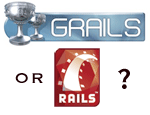Grails 1.0 and JRuby on Rails on WebSphere
 A couple of interesting things happened today that relate to my Grails vs. Rails quest for knowledge.
A couple of interesting things happened today that relate to my Grails vs. Rails quest for knowledge.
The first is that Grails 1.0 was released. This was apparently a huge event as it swamped Codehaus' servers for a couple hours. This morning, it was pretty cool to shake Graeme's hand and congratulate him on the release. I also got to meet Jeff Brown for the first time. Who needs to go to a conference when you get to talk to these guys at work? 
Secondly, I found an article by Ryan Shillington that shows how to deploy a Rails application to WebSphere. To me Rails + WebSphere seems like the last thing a Rails advocate would want - but who knows. In my experience, most developers that use WebSphere don't do it by choice.
For companies that have invested a lot of time and money into the JVM as a platform, it seems like Grails is the clear winner over Rails. However, the line gets blurry when you start talking about JRuby. I think JRuby will get there, but I don't believe it's there yet. If you look at the two major JRuby on Rails success stories (from Oracle and Sun), they've had to fix performance issues as part of their projects. With big companies investing in the platform, it's highly likely performance will be fixed in the near future. I believe both the Groovy and JRuby teams have said performance enhancements are their top priority for their next releases.
I think the biggest news related to performance of dynamic languages on the JVM is the new Da Vinci Machine project.
This project will prototype a number of extensions to the JVM, so that it can run non-Java languages efficiently, with a performance level comparable to that of Java itself.
Dynamic languages on the JVM seem to have a very bright future.
I got involved with Struts and Spring just before their 1.0 releases. Is it simply a coincidence that I happened to start looking into Grails right before its 1.0 release?


Posted by Mike on September 04, 2008 at 12:18 AM MDT #